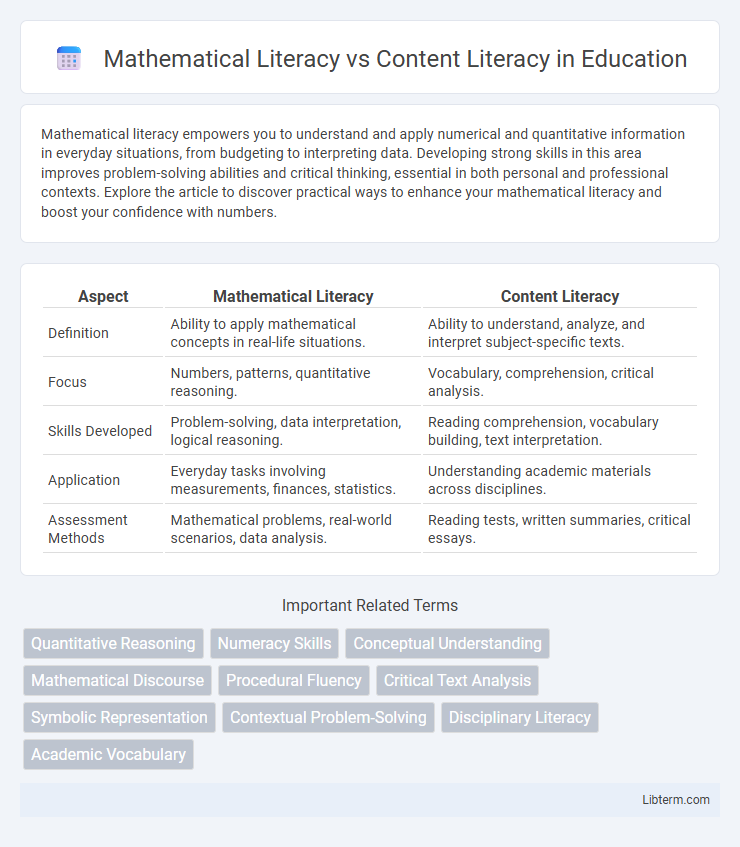Mathematical literacy empowers you to understand and apply numerical and quantitative information in everyday situations, from budgeting to interpreting data. Developing strong skills in this area improves problem-solving abilities and critical thinking, essential in both personal and professional contexts. Explore the article to discover practical ways to enhance your mathematical literacy and boost your confidence with numbers.
Table of Comparison
| Aspect | Mathematical Literacy | Content Literacy |
|---|---|---|
| Definition | Ability to apply mathematical concepts in real-life situations. | Ability to understand, analyze, and interpret subject-specific texts. |
| Focus | Numbers, patterns, quantitative reasoning. | Vocabulary, comprehension, critical analysis. |
| Skills Developed | Problem-solving, data interpretation, logical reasoning. | Reading comprehension, vocabulary building, text interpretation. |
| Application | Everyday tasks involving measurements, finances, statistics. | Understanding academic materials across disciplines. |
| Assessment Methods | Mathematical problems, real-world scenarios, data analysis. | Reading tests, written summaries, critical essays. |
Introduction to Mathematical Literacy and Content Literacy
Mathematical literacy involves the ability to apply mathematical concepts and reasoning to solve real-world problems, emphasizing critical thinking and quantitative analysis. Content literacy refers to understanding and effectively using domain-specific vocabulary and concepts across various subjects, enabling learners to comprehend and engage with academic texts. Both literacies are essential for academic success, but mathematical literacy focuses on numerical problem-solving, while content literacy centers on mastering subject-specific language and knowledge.
Defining Mathematical Literacy
Mathematical literacy involves the ability to apply mathematical concepts and reasoning to solve real-world problems, emphasizing comprehension beyond mere calculation. It integrates quantitative understanding with critical thinking, enabling individuals to interpret data, analyze patterns, and make informed decisions. This form of literacy transcends traditional content knowledge, focusing on functional use and practical application in everyday contexts.
Defining Content Literacy
Content literacy refers to the ability to understand, interpret, and use information specific to a particular subject area, such as science, history, or mathematics. It involves mastering the vocabulary, symbols, and text structures unique to that discipline to effectively comprehend and communicate complex ideas. In contrast, mathematical literacy emphasizes applying mathematical concepts and reasoning to solve real-world problems, highlighting numeracy skills rather than subject-specific reading comprehension.
Key Differences Between Mathematical and Content Literacy
Mathematical literacy emphasizes understanding and applying numerical data, patterns, and quantitative reasoning, while content literacy focuses on comprehending and interpreting text within specific subject areas. Mathematical literacy involves skills like problem-solving with numbers and symbols, interpreting graphs, and logical reasoning. Content literacy requires decoding specialized vocabulary, analyzing concepts, and synthesizing information across disciplines.
Importance of Mathematical Literacy in Modern Education
Mathematical literacy equips students with essential problem-solving and critical thinking skills necessary for navigating complex real-world situations, making it integral to modern education. It enhances numeracy, data interpretation, and logical reasoning, which are crucial in STEM fields and everyday life decisions. Emphasizing mathematical literacy prepares learners for a technology-driven economy and fosters informed citizenship in a data-rich society.
The Role of Content Literacy Across Disciplines
Content literacy plays a crucial role across disciplines by enabling students to comprehend, analyze, and communicate subject-specific information effectively. In mathematical literacy, this means understanding mathematical language, symbols, and problem contexts to solve real-world problems accurately. Mastering content literacy enhances critical thinking and interdisciplinary learning, bridging the gap between mathematical concepts and their practical applications.
Skills Developed Through Mathematical Literacy
Mathematical literacy develops critical skills such as problem-solving, logical reasoning, and the ability to interpret and analyze quantitative data in real-world contexts. It enhances numerical fluency, pattern recognition, and the capacity to make informed decisions based on mathematical information. These skills are essential for navigating daily life challenges and contribute to overall cognitive development beyond mere content memorization.
Enhancing Content Literacy in the Classroom
Enhancing content literacy in the classroom involves integrating mathematical literacy strategies that develop students' ability to interpret, analyze, and apply mathematical information effectively across subjects. Emphasizing vocabulary acquisition, comprehension of mathematical texts, and real-world problem-solving fosters deeper understanding and retention. This approach bridges the gap between abstract numerical concepts and practical application, empowering students to navigate diverse academic content confidently.
Challenges in Balancing Both Literacies
Balancing mathematical literacy and content literacy presents significant challenges due to their distinct cognitive demands: mathematical literacy emphasizes quantitative reasoning, problem-solving, and interpreting numerical data, while content literacy focuses on comprehension, critical analysis, and synthesizing information from texts. Educators often struggle to design curricula that simultaneously develop skills such as symbolic math manipulation and reading comprehension without overwhelming students. Furthermore, assessment methods may inadequately measure integrated competencies, leading to gaps in students' ability to apply mathematical concepts within diverse textual contexts.
Integrating Mathematical and Content Literacy for Academic Success
Integrating mathematical literacy with content literacy enhances students' ability to comprehend and apply mathematical concepts within various academic subjects, improving problem-solving skills and critical thinking. Effective strategies include contextualizing math problems in real-world and cross-disciplinary scenarios, which reinforces both numerical understanding and subject-specific knowledge. This fusion fosters academic success by enabling learners to navigate complex texts and quantitative data, essential for higher-level education and STEM fields.
Mathematical Literacy Infographic

 libterm.com
libterm.com